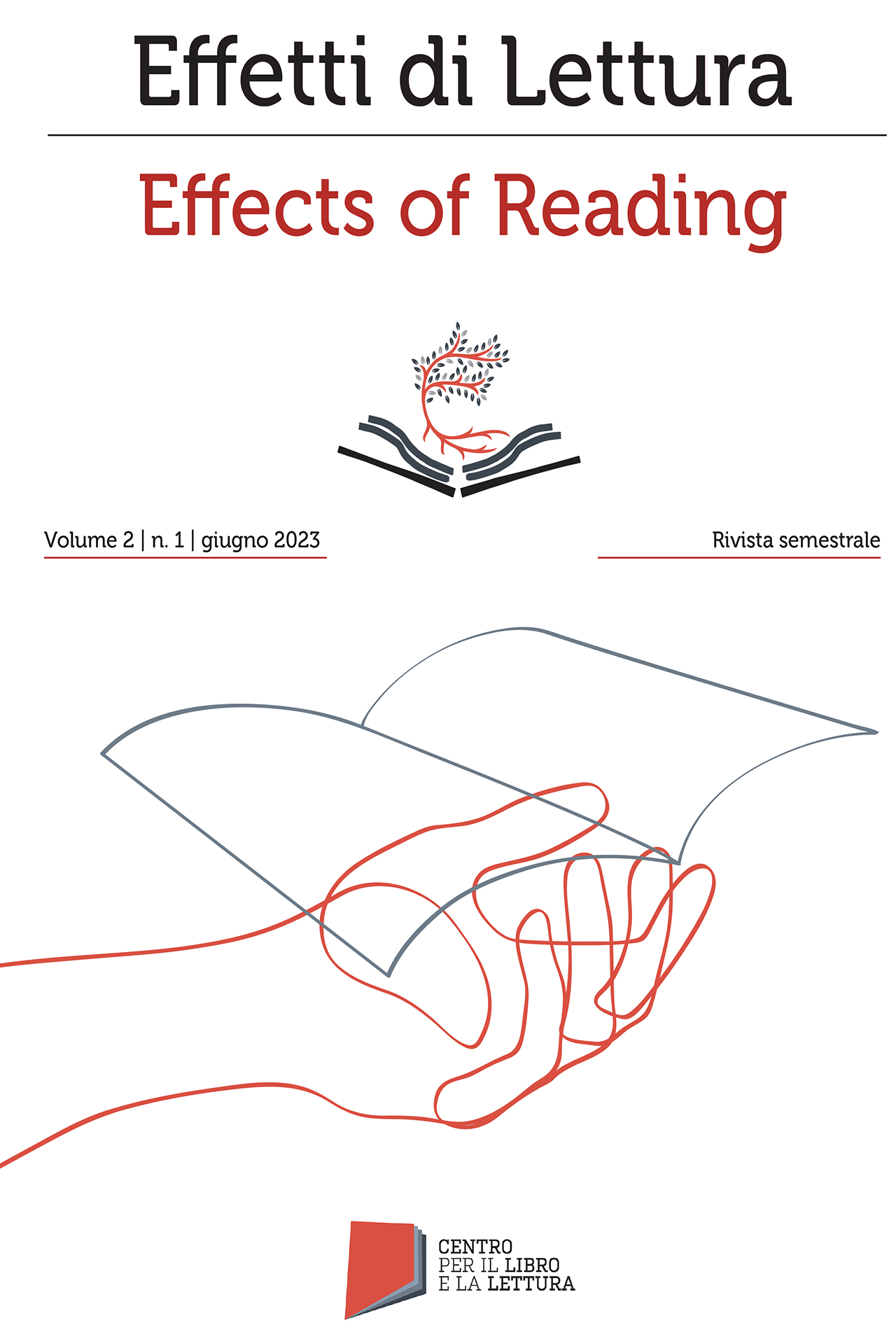La promozione della lettura ad alta voce: strumenti per l’innovazione della didattica universitaria e per la formazione degli educatori e degli insegnanti
DOI:
https://doi.org/10.7347/EdL-01-2023-06Parole chiave:
scienze dell'educazione;, letteratura per l'infanzia, XXI secolo, albi illustrati, lettura ad alta voce, Libri illustratiAbstract
In occasione del corso di Letteratura per l’infanzia del curriculum “Educatore dei servizi educativi per l’infanzia” dell’Università di Macerata (Corso di Laurea in Scienze dell’Educazione e della Formazione del Dipartimento di Scienze della Formazione, dei Beni Culturali e del Turismo), gli studenti hanno partecipato a una serie di seminari con rappresentanti del mondo scolastico, pedagogisti, librai, responsabili di progetti per la promozione della lettura fin dalla prima infanzia e hanno avuto l’opportunità di sperimentare alcune tecniche di lettura ad alta voce nella fascia d’età 0-3 anni. L’articolo si propone di presentare i risultati di questa esperienza – proposta dall’anno accademico 2020/2021 – dedicata alla conoscenza delle esperienze locali e dei progetti nazionali focalizzati sulla letteratura per l’infanzia e sulla lettura ad alta voce. Gli incontri sono stati utili per evidenziare i benefici della lettura ad alta voce fin dalla prima infanzia in termini di sviluppo cognitivo, linguistico, emotivo e relazionale, caratteristiche ampiamente dimostrate dalla ricerca scientifica negli ultimi anni. Gli studenti hanno poi avuto l’opportunità di condividere le loro impressioni e riflessioni e mettere in pratica ciò che hanno appreso durante l’esperienza di tirocinio e il lavoro di tesi finale. Si intende, quindi, dimostrare l’importanza di questi incontri formativi in contesti come l’università, in cui vengono formati i futuri educatori e insegnanti, che in questo modo non solo approfondiscono il tema della letteratura per l’infanzia, ma possono diventare consapevoli della potente pratica della lettura ad alta voce, che possono utilizzare in classe attraverso un prezioso strumento come il libro.
Downloads
Riferimenti bibliografici
Aram, D., Schapira, R. (2012). Parent-Child Shared Book Reading and Socio-Emotional Development, Italian Journal of Family Education, 2, 55-66.
Ascenzi, A. & Sani, R. (2017). Storia e antologia della letteratura per l’infanzia nell’Italia dell’Ottocento, Vol. I. FrancoAngeli.
Ascenzi, A. & Sani, R. (2018). Storia e antologia della letteratura per l’infanzia nell’Italia dell’Ottocento, Vol. II. FrancoAngeli.
Barsotti, S. (2015). L’albo illustrato un crocevia di linguaggi, Form@re - Open Journal Per La Formazione in Rete, 15(2), 207-217.
Batini, F. (2018). Leggimi ancora. Letture ad alta voce e Life Skills. Giunti scuola.
Batini, F. (2019). Leggere ad alta voce. Metodi e strategie per costruire competenze per la vita. Giunti scuola.
Batini, F. (Ed.) (2021). Ad alta voce. La lettura che fa bene a tutti. Giunti.
Batini, F. (2022). Lettura ad alta voce. Ricerche e strumenti per educatori, insegnanti e genitori. Carocci.
Batini, F., & Giusti, S. (Eds.) (2021). Tecniche per la lettura ad alta voce. 27 suggerimenti per la fascia 0-6 anni. FrancoAngeli.
Bruno, T. (Ed.) (2023). Fare scuola con le storie. Esperienze di educazione alla lettura in classe, Erickson.
Campagnaro, M. & Dallari, M. (2013). Incanto e racconto nel labirinto delle figure. Albi illustrati e relazione educativa, Erickson.
Capetti, A. (2018). A scuola con gli albi. Insegnare la bellezza delle parole e delle immagini, Topipittori.
Dunst, C. J., Simkus, A. & Hamby D. W. (2012), Effects of Reading to Infants and Toddlers on Their Early Language Development, CELLreviews, 5(4), 1-10.
Farina, L. (Ed.) (2013). La casa delle meraviglie. La Emme Edizioni di Rosellina Archinto. Topipittori.
Hamelin (Ed.) (2012). Ad occhi aperti. Leggere l’albo illustrato. Donzelli.
Hutton, J. S. et al. (2015). Home Reading Environment and Brain Activation in Preschool Children Listening to Stories, Pediatrics, 136(3), 466-478.
Law, J., Charlton, J., McKean, C., Beyer, F., Fernandez-Garcia, C., Mashayekhi, A., Rush, R. (2018). Parent-child reading to improve language development and school readiness: A systematic review and meta-analysis (Final report). Newcastle University & Queen Margaret University.
Meda, J. (2021). C’era una volta al grammofono... Le fiabe sonore della Durium tra tradizione e fantasia (1933-1950). In S. Polenghi, F. Cereda, P. Zini (Eds.), La responsabilità della pedagogia nelle trasformazioni dei rapporti sociali. Storia, linee di ricerca e prospettive (pp. 962-969). Pensa Multimedia.
Meda, J., Marazzi, E., Targhetta, F. & Ostenc, M. (2017). Nuove piste di ricerca per la storia della letteratura per l’infanzia: a proposito di un recente volume. History of Education & Children’s Literature, XII(2), 541-560.
Sola, S. & Vassalli, P. (2014). I nostri anni 70. Libri per ragazzi in Italia. Corraini.
Terrusi, M. (2017). Meraviglie mute. Silent book e letteratura per l’infanzia. Carocci.
Terrusi, M. (2012). Albi illustrati. Leggere, guardare, nominare il mondo nei libri per l’infanzia. Carocci.
Zago, G., Callegari, C. & Campagnaro, M. (2019). La casa nella Letteratura per l’infanzia contemporanea, Figure, modelli e visioni nella Letteratura per l’infanzia dal Novecento ad oggi, PensaMultimedia.
Zizioli, E. (2017). I tesori della lettura sull’isola. Una pratica di cittadinanza possibile. Sinnos.
##submission.downloads##
Pubblicato
Come citare
Fascicolo
Sezione
Licenza
Copyright (c) 2023 Effetti di lettura / Effects of reading

Questo lavoro è fornito con la licenza Creative Commons Attribuzione - Non commerciale 4.0 Internazionale.








